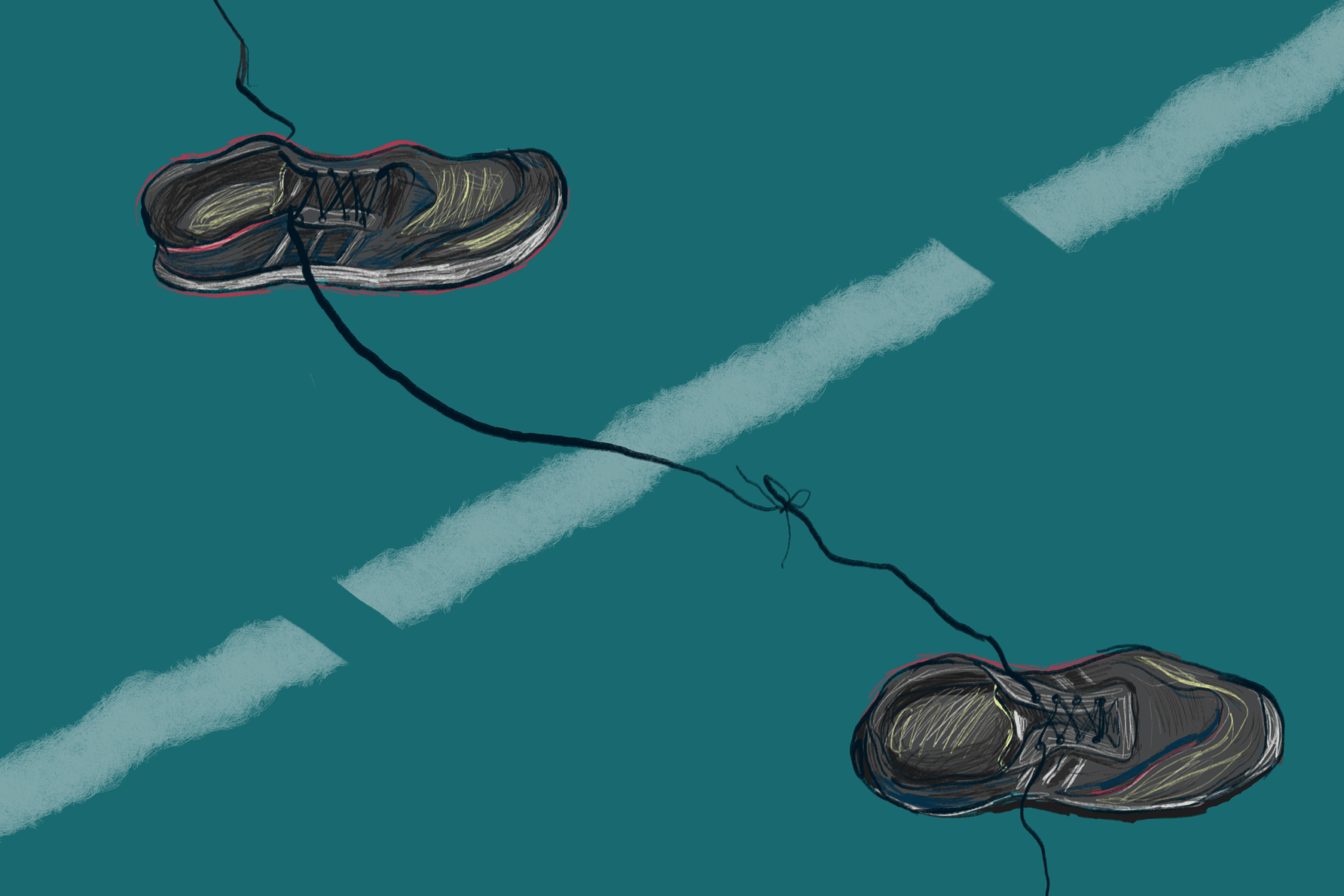Copyright brisbanetimes

Her mum noticed Howe’s new approach to food when she came home for Christmas 2023. “She’d stand and stare at the pantry, or open the fridge and just gaze inside,” says Sally, pulling out the red scales her daughter used to weigh her food. “I didn’t like all the measuring but didn’t want to interfere. When I did say something, Georgie would say, ‘Mum, I’m a professional athlete now, this is what we do.’ ” Sally’s worry grew in 2024 when she saw her daughter on FaceTime, puffy and anxious – then on TV. “I remember watching her in a race in Belgium at midnight one night and Nick [Owen] texted me and said, ‘Something’s not right,’ ” Sally says. “She wasn’t racing with her usual tenacity. She didn’t look like the Georgie we were used to seeing.” That Howe had lost her mojo was no surprise, given she was failing at the two things she’d been charged with doing: losing weight and performing. She wasn’t used to failure; like most athletes, talent, hard work and sheer determination had always got her where she needed to go. So she kept on pushing. To McGregor, this is typical elite-athlete -behaviour. “We can’t forget the athletes’ part in all this,” she says. “They will be a certain type: high achievers, critical of themselves, perfectionists.” That works for them – until it doesn’t. The job of their health teams, then, is to teach them when to keep pushing, and when, for the sake of their health, to pull back. That can be diabolically difficult for athlete and medico alike, given the short time frames in which athletes have to achieve their goals and the opaqueness around when they’re actually in a dangerous period of low energy availability (more on which, later). Taking time out for a broken arm is relatively straightforward. For a broken endocrine system, which might take a year or more to recover from – with the athlete still on the payroll – much less so. Luca Pollastri is medical co-ordinator with GreenEdge Cycling, which owns the team Howe rode for. He agrees that knowing when to pull an athlete out of training or competition can be -difficult, and says they use red and -yellow flags in their assessment. Red flags are fairly simple: if an athlete falls below a certain body-fat ratio, or loses a set amount of weight within a month, or hasn’t had their period for months, the medicos might pull them. Yellow flags are where it gets tricky: if it’s been fewer than 45 days since their last period, if things were moving in the right -direction but start going backwards, that’s when a judgment call is made. With a psychological component, trust between medico and athlete is key to deciding what to do in such cases, and that’s highly individual. “There’s not one single protocol we can follow that is fit for everyone. Within one group of doctors you can have different opinions.” On Howe’s case, and why she wasn’t pulled off the bike despite those worrying blood tests, a spokesperson for Liv AlUla Jayco declined to comment. Pollastri, who was not Howe’s doctor, says the team screens all riders for REDs at the start of each season via a questionnaire, and that any edict to lose weight would be done in consultation with the cyclist. “I don’t think it’s a directive to lose weight,” he says. “We discuss the goal for them, with them.” Endocrinologist Nicky Keay sees an education job ahead, in part to teach those running various sports to prioritise hard health data and actual performance over arbitrary weight and skinfold goals. “It’s the pervasive cultures: the weigh-ins, measuring body composition,” she says. “My message is to look after the health first, and the performance will follow.” Many refer to sports dietitian Louise Burke as the godmother of REDs, so I call her at the Australian Catholic University, where she’s a professorial fellow at the Centre for Human Performance & Metabolism, for a deeper understanding of the syndrome. Burke, who worked at the Australian Institute of Sport for three decades, was one of the co-authors of the 2014 and 2023 IOC statements. She calls REDs a clinical diagnosis of exclusion, made once other potential causes of health and performance problems are ruled out. It all revolves around low energy availability (LEA); in short, not -eating enough for all that training. Not that all cases of LEA are bad. “Given obesity levels, much of the world could do with some LEA,” Burke says, “but too much of it is a problem.” She explains that REDs can occur intentionally, for example when the athlete does have an eating disorder, or unintentionally, such as when they don’t realise they should be eating more for the training they’re doing. A 100-kilogram rower might be training so much they cannot eat enough food to make up for it. Alternatively, “some athletes who get sporting scholarships to the US might not have enough money to buy enough food”, Burke says. “Nor might some athletes in Third World countries.” Pippa Woolven, the former athlete behind the Project RED-S website, says it took her the best part of a decade to recover from REDs, involving not just eating more and training less but unravelling the vilifying -beliefs she’d internalised about fats and carbohydrates. “I had to show myself that if I ate properly, nothing bad would happen,” she says. “It was sometimes two steps forward, one step back, but I’m arguably the healthiest now that I’ve ever been.” Woolven is holding five-week-old baby Lawrence when we catch up on a video call from her home in Henley-on-Thames. She and her husband, Rich, a software engineer and former elite athlete who helped her design the Project RED-S website, also have a two-year-old, Alistair. “I never thought it would be possible for me to be a mum,” Woolven says, smiling broadly. “It’s not all doom and gloom. This is a condition you can recover from.” A former competitive cyclist – “I was a serious amateur, not at Georgie’s level” – José Areta is associate professor in exercise physiology and metabolism at Britain’s Liverpool John Moores University. He also works privately with athletes to -improve their health and performance. Argentinian by birth, Areta spent six years in Melbourne completing his PhD in sports nutrition in the early 2010s. “I loved it,” he tells me on a video call from Liverpool. “The coffee culture was unreal. I didn’t drink coffee before going to Melbourne. I did a lot of road cycling there, too.” A biologist by training, he sees sports nutrition through “an evolutionary paradigm”, which gives him a different perspective to many -others working in the area. Areta was one of eight authors behind a 2024 paper in Sports Medicine journal that threw the cat among the pigeons with the -provocative title, “Does Relative Energy Deficiency in Sport (REDs) Syndrome exist?” Their main point was that declines in an athlete’s health and performance might be due to low energy availability but might also be due to other things. Stress. Lack of sleep. Anxiety. Infection or some other undiagnosed medical issue. Things happening in their life that are completely unrelated to what they eat and drink and how hard they train. “We say there are many things that can cause these symptoms, which are very generic, and energy deficit is not the only thing,” Areta says. “We don’t have enough data to establish causality.” Part of the problem, he says, is how difficult it is to measure energy input and output, which “looks straightforward but isn’t”. This helps explain why pro-athletes with dietitians on the payroll can fall into LEA – because working out what to eat for your particular size, genetic make-up and training regimen, as anyone who has done any diet will tell you, is an inexact thing. There’s also the awkward fact that being lighter can be a competitive advantage. Areta points to research he did on Georgie Howe during the 2023 Tour de France Femmes. Despite already having infrequent periods, indications of an underactive thyroid and a negative energy balance, plus losing 2.2 kilograms during the eight-day race, Howe rode at world-tour level and had her “best performance yet” in the race’s final stage. Two weeks later, she finished in the top 10 at the world time trials in Glasgow. Asks Areta: “Would she have performed better if she’d had more food? We don’t know. What we can say is it appears high performance can be compatible with a state of energy deficit.” Similarly, 2025 Tour de France Femmes winner, Pauline Ferrand-Prévot, dropped a lot of weight before the race, causing much talk in cycling circles. “I can’t say she won the race because she dropped a lot of weight, but she won the race having lost weight,” says Areta. “It’s quite a complex topic and I can understand how it can be polarising.” Letters went back and forth after the “Does REDs exist?” paper. “Yes REDs does exist!” was the title of a letter to the editor in which 17 authors, including Louise Burke, said that while they agreed with much of what Areta and co said – yes it is difficult to accurately measure energy availability, yes it can be over-simplified – waiting for long-term studies to establish causality would be both “unfeasible and unethical”. They concluded with the punchy statement that “as sports medicine physicians, psychologists, physiologists, scientists, dietitians, coaches and athletes, we – the IOC consensus co-authors – know that REDs exists. We see and treat it in our athletes daily.” Areta and his colleagues returned fire, arguing that a statement like “we know that REDs exists” was “not compatible with the scientific process” and that “we believe it is important to challenge dogmas and encourage rigorous -scientific processes”. Those working on the diagnosis frontline stress that REDs is a clinical call, made on a patient in front of them, based on what they see and hear from that patient, ruling things like Areta’s other reasons for problems in and out. Renee McGregor does not dispute that Howe performed well while in a state of LEA during Areta’s trial, and agrees that lighter can lead to better results in the short term. Hence, many athletes successfully manipulate their weight in the lead-up to competition. In the longer term, however, she argues, it will catch up with them. In Howe’s case, it was eight or so months after Areta’s research on her that everything started going wrong. “People can get away with under-fuelling for up to 18 months before seeing negative consequences,” McGregor says. “By the time they turn up to me with a problem, their body is often in a pretty poor place and they can’t identify the behaviour that’s got them to where they are.” What they all agree on is that more research needs to be done: on the causality links between weight loss, health and performance, on why some athletes who lose weight rapidly will develop REDs and others won’t, on how an athlete’s particular genetic make-up plays into all this, just for starters. On women athletes in general, on whom only 6 per cent of sports medicine research has traditionally been done. As physiologist Stacy Sims is fond of saying, “Women are not small men” – meaning systems designed for male athletes can’t always be simply transferred across to women. The difference in women’s physiology and psychology needs to be better understood, and adaptations made where required. Given the rising numbers of women participating in sport, and an associated flow of money into it, there’s hope more -research will eventuate. Meanwhile, the question we should be asking, Areta says, is: “What price are you willing to pay to win the race? And is this a price you should pay?” What price, indeed. In mid-2024, after Georgie Howe pulled out of that final race, she caught the train to Paris, where she met her parents and friends ahead of the Olympics. They went for dinner to a local wine bar, where Howe ordered steak frites, and drank beer. She measured nothing. “I saw the joy start to come back in her eyes,” says Sally. One day, Howe went for a leisurely cycle along the road race route. “I’d stop at boulangeries and get a croissant if I felt like it,” she recalls. “Previously I’d have said, ‘No, not today, you don’t need that today.’ ” I ask Sally and Nick whether, knowing what they know now, they’d encourage their daughter into pro-cycling. No, says Nick, a Tour de France tragic: “There’s always sacrifice, a lot of social activity you miss out on, but I don’t think any young person expects to have their health permanently impacted by pursuing a particular sport.” Sally, a former nurse and health administrator, and a former board member of Swimming Australia, says no, too. She says she’ll know things have improved when endocrinologists are par for the course on sport medical teams. “Do no harm – that’s the first rule, isn’t it? That’s the lens that should be put over every decision. And too often, it isn’t.” Howe recently had her 12th menstrual cycle in a row, a sign she’s coming out of REDs. She’s been working in a friend’s bike shop in Collingwood and writing and podcasting for various cycling publications. Last month, she began a new job with a sports marketing firm, and she’s looking to move out of home again with some mates. She’s getting her mojo back – but the costs are still front of mind. Recovery is still a work in progress. “The penny really dropped for me when I went to see my psychiatrist recently, and he validated my feeling that sometimes being an athlete is the worst job in sport,” she says. “Because you retire and in the transition out you realise, ‘Holy shit, I really was just a commodity. They really didn’t care about me.’ ” To read more from Good Weekend magazine, visit our page at The Sydney Morning Herald, The Age and Brisbane Times.



